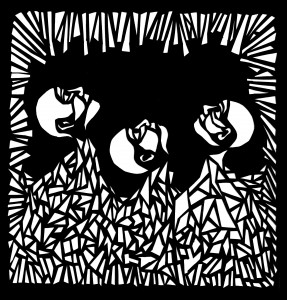 Both a strength and a weakness of the network of bands in Glasgow is its incestuous nature. The entire family tree is no doubt fantastically obscure and many dimensional, with individuals often featuring in many bands at once or drifting in and out of them over time. This of course makes keeping any sort of track of bands and members almost impossible for the listener. But this camaraderie surely pays dividends when the chips are down, and it's heartening to see a scene in action where collaboration seems more common than competition, most of the time at least. And, somewhere on the edge of this dizzying, intriguing and remarkably complicated world are John Knox Sex Club - at once connected via other bands and allegiances, and somehow very much separate from what's happening. They have a minimal online presence, which musically speaking nowadays is akin to becoming a cave-dwelling hermit. But behind this deceptively quiet, almost reluctant exterior is a raging storm of noise and tension. Having stabilised around a six-piece line up, "Raise Ravens" is the second substantive release for a band which reputedly never intended to record anything at all.
Both a strength and a weakness of the network of bands in Glasgow is its incestuous nature. The entire family tree is no doubt fantastically obscure and many dimensional, with individuals often featuring in many bands at once or drifting in and out of them over time. This of course makes keeping any sort of track of bands and members almost impossible for the listener. But this camaraderie surely pays dividends when the chips are down, and it's heartening to see a scene in action where collaboration seems more common than competition, most of the time at least. And, somewhere on the edge of this dizzying, intriguing and remarkably complicated world are John Knox Sex Club - at once connected via other bands and allegiances, and somehow very much separate from what's happening. They have a minimal online presence, which musically speaking nowadays is akin to becoming a cave-dwelling hermit. But behind this deceptively quiet, almost reluctant exterior is a raging storm of noise and tension. Having stabilised around a six-piece line up, "Raise Ravens" is the second substantive release for a band which reputedly never intended to record anything at all.
If anything truly deserves the much overused 'epic' tag it is surely the opening 'Kiss The Dirt'. Just shy of a portentous thirteen minutes long, this starts out as an almost gentle, lyrical sweep across an urban landscape of tower blocks and abandoned houses, but becomes almost evangelical rather like the John Knox Sex Club live experience. A pseudo-religious refrain of "all that is lost will be found" tops a mesmerizingly repetitive shard of violin, ending in a thunderous explosion of bass, guitar and drums. Sean Cumming desperately howling his oaths to the very end with a repeated, humbling "I'll kiss the dirt beneath your feet". From the outset then, this is awe-inspiring and almost uncomfortably moving music. In comparison, "Above Us The Waves" is a gentle piece with the violin carrying a soaring, life-affirming melody. But even here there is a hint of darkness with a shudder of delay-laden distorted guitar beneath the impassioned vocals. Lyrically too, the close-observation gives away a morbid and dark undertone - dead wasps, the smell of fresh earth - Cumming weaves claustrophobic tales which are highly suggestive and unsettling but never graphic.
Emer Tumilty's strangely sorrowful violin ushers in "Sweet Sing The Rails Go Leave, Go Leave" with the gentlest of guitar lines in the background, reverberating and chiming. A beautiful, well placed instrumental which provides a sense of release and sanctuary. But still dark tinged and sorrowful. Initially "The Neighbours" is driven by Cummings melodic vocal lead, a domestic drama delivered via forensic observations: "her mother disappeared into tiny worlds of figurines". The chorus is a swell of voices, including a higher register female voice which provide a counterpoint to Cummings insistent exhortations. Detailing a private world of obsession, there is a sense of a desperate clinging to the past and implied violence. A duet of sinuous guitar and whooping violin drives the song onwards, weirdly, incongruously upbeat, to its crashing nightmarish climax, before a quiet sad coda makes the implicit explicit and we are left with fear and tension. Interesting in its obscure origins "Katie Cruel" is a gentle, almost delicately delivered traditional song. A strangely unspecific tale of regret which doesn't really reveal much about the predicament of the eponymous heroine, the song's origins are buried somewhere in Scotland and filtered though a transatlantic crossing somewhere around the time of the American Civil War. Utterly beautiful violin work is again the star of the show, winding an appealingly melancholy tune around the lament of the vocal. Finally, "The Thaw" comes on like Codeine or Slint, all pensive post-hardcore minor chords and taut Albini-style tinder dry drums. Dueling guitar and violin melodies shift the song in more chaotic directions with Cumming speaking the lyric in disturbingly calm, measured tones over his own singing. A squall of noise reflects the confusing intensity of the blizzard, before gentle plucked violin notes drip into a quiet, tensely melodic passage with a desperate imploring reminder that "the grass grows beneath the ice and snow" delivered over spirals of noise and shrilling strings.
Reading back, I suspect my ramblings are barely adequate to convey quite how this music works. Somehow John Knox Sex Club combine a firm grasp of tradition with the confidence to twist it to their own ends, rather than slavishly repeating things. Allied to a quietly powerful rhythm section which anchors the wayward violin and burst of searing guitar, the result is a record full of pent-up tension and menacing quiet passages which contain the threat of unexploded devices. When this energy is released the maelstrom is compelling and beautiful. However reluctant John Knox Sex Club feel about self-promotion, there is absolutely no way that something this powerful and darkly lyrical should remain unsung.
You can buy "Raise Ravens" from Bandcamp as a digital download. An extra pound gets you a beautifully packaged CD in a gatefold sleeve, printed and hand-assembled by the band themselves in addition to the download.
John Knox Sex Club - The Neighbours
It's six weeks now since I did an organised railtour, and I've fallen into a pattern of revisiting places rather like I did a couple of years back. This way, I still get my beloved rail journeys but end up somewhere I visited some time ago, with the intention of looking at the place through fresh eyes. Over the last few weeks I've gravitated to the southern end of the West Coast Main Line - not least because the range of cheap London Midland tickets has made some interesting journeys possible. Today again I used these to build a trip over familiar territory - an early start as ever, though delayed a little by signalling problems close to home. Still time for my customary refreshment at Bristol before boarding the 07:00 to Birmingham. Indifferent weather, but good just to be out and about. A change here for a Nuneaton train which was a little busier, and something of a wait once I arrived. Busied myself with a trip to the nearby supermarket which I'd discovered a couple of years back, getting back to the platform in time to see celebrity Pendolino 390054 pass by, a little before a tour using 50044 on the WB64 Virgin rake. Didn't mind the minor delay this caused to proceedings at all, and we were soon off and heading up the Trent Valley to Stafford. A quick switch here, as I've become used to making, and onto a Liverpool-bound unit for the rest of the trip.
Arriving at Liverpool remains a familiar experience, though the station is a much open and lighter proposition since the area immediately outside the trainshed was cleared. The concourse still feels oddly squashed at it's northern end by the 1980s retail and gateline block, but the exit to the south is impressive. Got my legs working with a wander down the steps and into the city - familiar enough territory, and I've got this far on recent trips. Noted though how Liverpool is built of layers of redevelopment - the recent work near the station gives way to the 1970s entrance to the City Centre - brick underpasses and a confusing hotel/shopping centre complex. Then, in the city itself, I began to encounter Liverpool ONE. I'm not sure what, or indeed where this is - its a sort of pervasive mall which has commandeered the street-pattern for it's own ends. I can't find a map of it either, and that causes me unease. Suffice to say, there is an area of what appears to be normal, if tidy and well-maintained, city streets into which the Big Issue sellers won't stray.
I decided to walk towards the docks - where I hadn't been for maybe ten years. Here another layer of development becomes apparent. Between the city and the dockside there had been an uneasy strip of former warehouses. Some had just begun to enter new use when I was last here - as loft apartments and clubs - but much remained derelict despite being on the route to that much championed resort at Albert Dock. Now though, one side of the street is a shining curve of modern hotels and boutiques. The other side retains it's old buildings, but they are all in use now. I pass a giant Tesco store, discretely fitted into the streetscape and realise something rather frightening - the local transformation has even subdued the massive retail giant which is Tesco, the much-defended brand being forced to share a sign here - "Tesco Liverpool ONE". The curve of the street delivers me to the new Bus Station, already moving from it's position near the railway when I visited years back. Beginning to feel like I was in some comic-horror film, I noted that here too things had changed - even at the "Liverpool ONE Bus Station"!
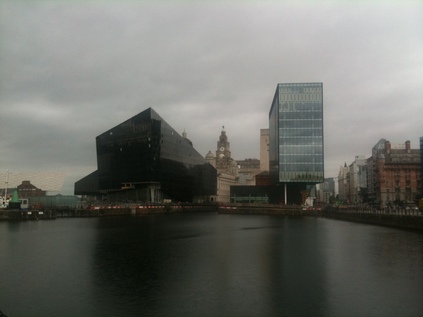
It becomes apparent here from an uneasily sourced map, that I've walked the edge of the development. Hanover Street, formerly a mildly menace-laced plunge into dereliction is now the edge of Liverpool ONE. Here I decided to brave the six-lane highway which Wapping has become to get to the original development zone - Albert Dock. Little has changed here since it's late 1980s transformation into a cultural hub. The Tate still busy with punters, though looking a little tired in it's design now. No giant weather map floating in the dock since "Richard and Judy" defected to evening TV and minor scandalmongering. What is interesting is how the area to the north of the Dock is changing. Stumbling over the mock-antique cobbles - currently being replaced it seems with exact replicas of replicas - and the restored bridges takes me into the Canning Wharfs area. What is most immediately apparent is how a black shard of a building has obliterated the skyline. The Liver Building cowers behind this obsidian monster - which in other circumstances could be rather dramatic. Here though, it just subtracts from the city. I edge around it, noting signs which describe how "government cuts" have called a halt to development of the docks. Making the point, a semi-permanent ring of metal fencing makes you walk the long route around. The signs, amusingly, built with funding from the Dept. for Culture Media and Sport. Enough in the bank for the testy politicians of Liverpool to declare their independence as per tradition then, with some sort of Recession-based Theme Park. Rounding the black glass office with camera out, a security guard takes an interest. He's bored, alone and is ignoring all the Japanese tourists with cameras. I don't want a repeat of last week, but he settles for walking a few paces behind me, pretending to peer into the empty offices. He need not really pace the circuit, you can see straight through the building anyway.

Back into the city, and the heart of Liverpool ONE. It's teeming with shoppers, it's spaces managed carefully to exclude the undesirable. On the fringe, a small protest about the impending release of Jon Venables was taking place. A single angry woman barking into a megaphone, while her friends offer a petition to bystanders. None of this inside the unofficial cordon though, and my walk back to the station unravels the layers of development, while dodging retail-blinded shoppers who seem to come at me without seeing me - an achievement in itself perhaps.
The journey home is sleepy and thoughtful. I'm not sure what to make of Liverpool now. It had always felt a hopeful, developing place - but now the work is done, it has lost something of it's character perhaps. It has also lost the 'Beatles as a Brand' mentality to some extent too, which is probably a good thing. Fewer businesses seem to stake their unsteady survival on the legend of the Fab Four. I wonder, if I'll encounter similar changes elsewhere as I re-explore other cities? It's an interesting if rather alarming journey.
My attitude to Kent has changed a lot of the years. Originally put off by the dull dash through the flat, featureless centre of the county, it took the serious attempt to cover all of the UK lines, along with an All Line Rover years back to start to dispel the image. Since then, when I've had weeks to spare for my own self-organised travels, I've made a number of jaunts out into Kent. Not least because it means part of a day in London if I want to come back early too. This time though, I decided I wanted to visit Margate. Not sure why or what might have spurred this, but I realised that on my many trips this way I'd never stopped off here. Add to that the fascination I have with seaside places, and the dim knowledge of artistic links with Tracey Emin and the like, and I suppose I got rather curious. I'd mentioned it to a number of people at work and they'd all remembered Dreamland. A turn-of-the-last century attempt to import the theme park concept and add a little twist of Britishness. I was intrigued by this, and set-off with an explorer's enthusiasm this morning.
The trip went smoothly enough...customary switch at Weston, breakfast and a pleasantly quiet run up to London. A quick spin on the Circle Line to St.Pancras, and time to get a coffee and head for the platform where Javelin No.8 was waiting to whisky us along HS1 and into Kent. Soon, off and speeding under London as a noisy family settled into the seats beside me. Put it out of my mind and enjoyed the sense of speed as we dashed through North Kent and down to Ashford. Here things slowed to what felt like a crawl as we progressed on old fashioned third-rail tracks via Canterbury West and onto the coast at Ramsgate. The weather had varied dramatically as I sped east - dark rolling clouds, some short showers, but now surprisingly bright sunshine. I finally stepped out into Margate for the first time, having no real idea what to expect. As it happened things were going to get rather eventful...
After taking a look at the impressive station building, I walked down the slope near a strangely inviting Premier Inn onto the prom. Nearby, all of the shops in a strange concrete arcade were shuttered and things seemed closed. Towering from the top of the arcade was a huge, oddly corrugated looking towerblock. It still seemed to be lived in, just about. Turning the corner, the remains of a shopping arcade tunnelled deeper into the concrete. Blocked off at the end by a steel pallisade fence which was sprouting vegetation, only a couple of shops seemed active - a fairly run-down looking cafe and a joke shop which had been provisionally amended to be a 'Bong Shop'. I shuffled on, passing some blue hoardings of the kind beloved by stalled developers. Looking at the aspirational images pasted onto them I realised that this was, in fact, dreamland. Almost entirely gone now, the posters promised a new Dreamland, saved from the jaws of residential development with Sea Change and Heritage Lottery Fund money, a new 'heritage' theme park would rise here. Some day.
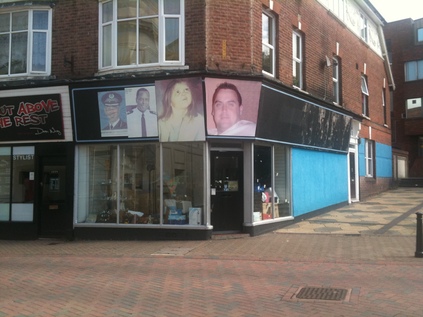
Passing the front of Wetherspoons, the first open business I'd seen, I noted the shuddering early drinkers fumbling with tobacco and watching traffic on the prom. A gentle rise brought me to the High Street, a narrow pedestrianised affair, jammed with lower rent national chains, such as Wimpy - which I only seem to find in Kent these days. At the top, opposite a nameless junkshop which featured pictures of leading policemen and odd portraits instead of a name, I saw a view down a steep hill into a massive vacant area littered with twisted metal and broken stone. A little mental geography made me realise that this was the remains of Dreamland. Stumbled down the hilly street to the pallisade fence which seems to be everywhere here, and pressed my camera through the bars.
I felt a presence nearby as I took some shots of the place, zooming in on an abandoned, peeling arcade and a collapsing rollercoaster. I thought nothing of it - people pointing cameras are always fair game for passing voyeurs - more to see what they're looking at than as subjects themselves. However, a tap on the shoulder and the presence of an unmarked white van confirmed my worst fears - security. After a brief altercation during which my camera was manhandled, and the Police were briefly involved - much to their disdain - the security guard, a square, pale-faced and haunted looking character, finally asked me in his esturine accent "So, why was you takin' pictures 'ere then?". I thought a bit about what might be least annoying or incriminating and replied "Well, it's just interesting I suppose". He looked at me first with disbelief and then with unfettered disgust. He spat the words "Fuckin' pervert" as he got back in his van and left. The bored Policeman watched him go silently, and to quell the awkwardness I said "Well, I might take some pictures then!". "Better not push it" he replied, and disappeared off into what was sure to be a busy Bank Holiday weekend.

The rest of my visit was less eventful - descending the High Street I entered a strange zone of clubs, alternative clothing and semi-legal stimulant shops. The street was directly above and behind the promenade here, and some of the stores had ground floor entrances there too, including a vast Primark branch. At the end of the High Street though was the Old Town. A mixed up neighbourhood of old squares, impressively unchanged buildings and painfully cultural boutique businesses. A pleasant area, flanked by the monstrosity of Morrisons which must have destroyed more of this landscape when it was parachuted into town, likely in the 1980s. I decided to head back to the railway station, via the preparations for a vast performance artwork tonight - Blink Margate which promised to re-imagine the seafront. After taking a few shots around the concrete monstrosity of Arlington House where I came in, I pondered Margate from the "Standing Stones" sculpture between station and sea, as bits of conversations drifted by "she said I was on drugs...well, that's Margate". I read too, that Tesco had purchased the rear of Arlington House, beyond the pallisade fence the illogical and forbidding carpark, a concrete maze, was being transformed. Locals bickered about the store - good for town, bad for locals. Hard to say. I saw plenty of my home town's troubles here too.
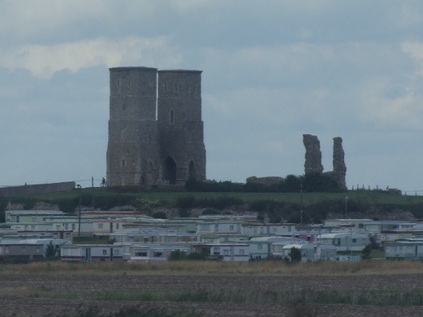
Back on the train, I took the slower, traditional route back to London Victoria. A sleepy, warm trip - despite a flash of very heavy, tropical rain on the coast. Black, tumbling clouds rolled over the cliffs and framed Reculver Abbey, subject of recent reading. I took snaps of the towers through the dirty windows. I wished I'd had the energy and drive to get out to them on a bus or something, but the urban exploration had left me curiously tired and rather forlorn. Work pressure hemmed me in, I was worrying again. Maybe a good sign after an impassive and uncaring summer? The ruined abbey was oddly comforting. I decided on arrival to take a bus across central London, to pop into Euston again. As I left, another bus back to Paddington, another sudden tropical storm lashed down, despite clear blue skies south of the river. It had been a very strange day, but an eventful and interesting one. I read and pondered my way home in a curious and thoughtful frame of mind...
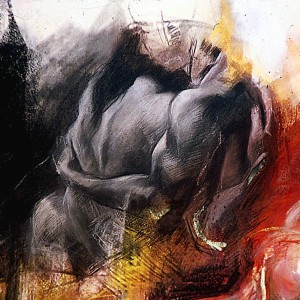 A lot of the louder music I've been listening to recently has been pretty messy, ramshackle stuff. I'm not sure if it's down to the resurfacing of a rebellious streak as middle age gallops down the tracks towards me, or whether its just the fact that I've always had a weakness for a muddy mix and a buried gem of a tune? Having said that, there are now probably a few too many bands dusting off their older brother's collection of lo-fi 1990s music and mining it for ideas, and against that backdrop of a concious dumbing-down and scumming up-of guitar pop just now, arrive Trapped In Kansas. Muddy and half-finished this absolutely isn't - from the beautiful Francis Bacon inspired cover art onwards there is concious, careful design at work here, and from within the confines of a pretty traditional rock band set-up, this Glasgow based four-piece manage to arrange some epic, moving and beautifully complex music. The much disputed and fairly meaningless term 'math rock' might well arise, but there are none of its cold, soulless implications here at all. Then again, if it suggests that we're dealing with complicated, technically proficient and challenging music, then it's accurate - but the bright clean guitar sounds radiate a warmth almost never encountered in that genre.
A lot of the louder music I've been listening to recently has been pretty messy, ramshackle stuff. I'm not sure if it's down to the resurfacing of a rebellious streak as middle age gallops down the tracks towards me, or whether its just the fact that I've always had a weakness for a muddy mix and a buried gem of a tune? Having said that, there are now probably a few too many bands dusting off their older brother's collection of lo-fi 1990s music and mining it for ideas, and against that backdrop of a concious dumbing-down and scumming up-of guitar pop just now, arrive Trapped In Kansas. Muddy and half-finished this absolutely isn't - from the beautiful Francis Bacon inspired cover art onwards there is concious, careful design at work here, and from within the confines of a pretty traditional rock band set-up, this Glasgow based four-piece manage to arrange some epic, moving and beautifully complex music. The much disputed and fairly meaningless term 'math rock' might well arise, but there are none of its cold, soulless implications here at all. Then again, if it suggests that we're dealing with complicated, technically proficient and challenging music, then it's accurate - but the bright clean guitar sounds radiate a warmth almost never encountered in that genre.
Taking centre stage from the beginning, perhaps atypically for a band which is built around the interplay of a group of skilled musicians, is Finn LeMarinel's voice - warm and full of character which immediately hooks you into his complex lyrics. The vocal leaps and somersaults around the music, and infuses the quieter passages of these songs with depth and emotion which it's fair to say isn't always easy to achieve in this kind of work. Perfectly illustrating this is "The Mask Does Wear The Man", an echoing and glacial post-rock tinged opening, the sparse bones of which are warmed by heartfelt vocals over the solo guitar. The motif Returns later as an instrumental interlude between tracks which lends a satisfying symmetry to proceedings too. As the first track drifts away, "I Was Born" ushers in a change of mood. A recent digital single, this song exudes technical prowess and artistry. Guitar melodies tumble over each other in an effort to have their moment at the front of the mix, while tempo changes coupled with the sometimes whispered, sometimes growled vocals shift the mood of the track. Lyrically, this seems to be a refugee's tale of disconnection and dislocation, with references to "leaving behind what we've known" in the face of impending war. LeMarinel's lyrics are sometimes oblique and surreal, but are equally capable of devastating, forensic incisiveness at times.
Next up, "Stick To The Roads" is wonderfully focused pop with an infectious and exuberant chorus. My one, and to be frank, utterly pathetic and irrational issue with this EP arises here though and I'm sorry to report it's a pretty anally retentive language-geek one too. Put simply, I just can't stop hearing the repeated periphrasis in the lyrics - in other words, those flips of word order and extra syllables inserted to mark time or switch the rhyme around. This is a favourite lyrical technique in Trapped In Kansas tracks at times which generally doesn't worry me at all, but it reaches a pitch on the chorus here with the repeated refrain of "the man DOES wear the mask/the King DOES where the crown" and such like. Those extra "do" and "does" moments, though a time-honoured and valid poetic technique, feel strangely archaic and make things sound a little rushed somehow. While I feel utterly ridiculous for raising it, I guess I'm opening my own scribblings up to intensive examination too now! It's particularly irritating because otherwise I adore this track, with its bursts of melody and self-assured pop construction. You can listen to it below, and tell me what a complete post-modern idiot I'm being later....
Recovering from my frustrated academic's hissy fit, there are more robust, tougher guitar lines threaded through "Skin and Bone" but it's still sprinkled with enough melody and dramatic shifts in time and mood to utterly confound attempts to pin it down. Finn's lyrics are at their visceral best here, and it seems he is rarely more comfortable than when he is scientifically dissecting or exposing situations. Not unlike the cover painting and it's inspirations, this graphic but ultimately very human approach seems to suit this track particularly as it builds towards a crashing, epic peak. "Happiness is an Allegory, Sadness a Story" quite apart from having an intriguing title, again treads a noisier path in places - but balances this against sections of quiet, blissed-out utter loveliness. The triumph here is the choir of backing vocals and the complex drum fills which pepper the track, making the explosive choruses of "I see a black cloud over you" all the more dramatic when they finally land. The thunderous, chugging guitar ending, with it's wide-screen solo is a splendid way to bring this record to a close.
This EP presents some of the most intelligently constructed, assured guitar music I've heard for some time. It delights in it's technical skill but is never brash or showy. Most of all, the band manages to play all kinds of neat tricks with mood, colour and tempo to produce an amazingly broad sweep in just these six tracks. All this of course begs the question of what Trapped In Kansas could achieve in the space of an entire album, and I hope we get to find out soon.
The "How To Go" EP is released on 3rd October on the band's own Overlook Records label. Meanwhile, Trapped In Kansas play The Wizard Festival near Banff this weekend, 26th and 27th August.
Lost::MikeGTN
I've had a home on the web for more years than I care to remember, and a few kind souls persuade me it's worth persisting with keeping it updated. This current incarnation of the site is centred around the blog posts which began back in 1999 as 'the daylog' and continued through my travels and tribulations during the following years.
I don't get out and about nearly as much these days, but I do try to record significant events and trips for posterity. You may also have arrived here by following the trail to my former music blog Songs Heard On Fast Trains. That content is preserved here too.




